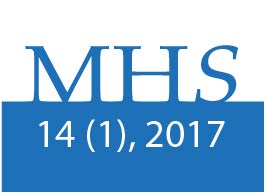Comparison of Physical Fitness and Body Composition Components in Parkour Practitioners Based on Years of Training
DOI:
https://doi.org/10.15359/mhs.14-1.5Keywords:
parkour, body composition, physical qualities, physical fitnessAbstract
The purpose of the study was to compare physical fitness and anthropometric components in parkour practitioners and find out how years of training influence these variables. Methodology: A total of 18 males participated in the study, who were divided in 3 groups based on years of training. Measurements were taken of anthropometric variables: height, weight, skeletal muscle mass, fat mass, body mass index, as well as physical fitness variables: flexibility (hamstring extensibility), power in upper and lower limbs and resistance to explosive force. One-way ANOVA was used for the independent groups and the Tukey’s post hoc normality test was used to determine significant differences, at an alpha level of p <.05. Results: no significant differences were found between the groups in any of the anthropometric variables. However, significant differences were found in the component physical fitness, bipodal horizontal jump (P = .02), CMJUL (Countermovement Jump applied to upper limbs) (p = .01) and CMJ (Countermovement Jump) (p = .00), being the group with more years of training the highest of the three. Conclusions: results showed that body composition in parkour athletes was not influenced by years of practice. However, differences found in physical fitness variables, years of training seem to have effects on performance, especially in the physical power of the lower and upper train.
References
Abellán-Aynés, O., & Alacid, F. (2016). Anthropometric profile, physical fitness and differences between performance level of Parkour practitioners. Arch. med. deporte, 33 (175), 312-316.
American College of Sport Medicine. (2014). ACSM’s Guidelines for exercise testing and prescription. Lippincott Williams & Wilkins.
Baechle, T. y Earle, R. (2007). Principios del entrenamiento de la fuerza y del acondicionamiento físico. Madrid: Médica Panamericana. ISBN 9788498356540
Bernadot, D. (2001). Nutrición para deportistas de alto nivel. Barcelona: Hispano Europea.
Bosco, C. (1994). La valoración de la fuerza con el test de Bosco. Barcelona: Paidotribo.
Carratalá, V., Pablos, C. y Carqués, L. (2003). Valoración de la fuerza explosiva, elástico-explosiva de los judokas infantiles y cadetes del equipo nacional español. Valencia: Universidad de Valencia.
Centeno, R. (2013). Valores de referencia para saltos en plataforma dinamométrica en una población de deportistas andaluces (Tesis doctoral). Universidad Pablo de Olavide, Sevilla. Recuperado de http://hdl.handle.net/10433/781
Cometti, G. (2007). Manual de pliometría. Badalona: Paidotribo.
De Hegedüs, J. (2008). Teoría y práctica del entrenamiento deportivo. Buenos Aires: Editorial Stadium SRL.
Farrally, R. (1982). The physical fitness of Scottish schoolboys aged 13 and 17 year. Evaluation of motor fitness. Belgium: Council of Europe Committee for development of sport.
Fetz, F. y Kronexl, E. (1976). Test deportivo motores. Argentina: Kapelusz
Gallego, J., Collado, P. y Verdú, J. (2006). Nutrición en el deporte: ayudas ergogénicas y dopaje. España: Ediciones Díaz de Santos.
Grospretre, S. & Leper, R. (2015). Performance characteristics of Parkour practitioners: Who are the traceurs? European Journal of Sport Science. DOI 10.1080/17461391.2015.1060263
Holway, F. (2005). Datos de Referencia Antropométricos para el Trabajo en Ciencias de la Salud: Tablas “Argo-Ref”. Argentina: Club Atlético River Plate.
Leite, N., Junior, A., Cieslak, F., Ishiyama, M., Milano, G., & Stefanello, J. (2011). Physical fitness profile of Le Parkour practitioners. Revista Brasileira de Medicina do Esporte, 17(3), 198-201. DOI: 10.1590/S1517-86922011000300010
MacDougall, J. D., Wenger, H. A. y Green, H. J. (Eds.). (2005). Evaluación fisiológica del deportista. Badalona: Editorial Paidotribo.
Marchetti, P. H., Junior, D. A. L., Soares, E. G., Silva, F. H., Uchida, M. C., & Teixeira, L. F. M. (2012). Differences in Muscular Performance between Practitioners and Non Practitioners of Parkour. International Journal of Sports Science, 2(4), 36-41. DOI: 10.5923/j.sports.20120204.02
Martin, D., Klaus, C. y Lehnertz, K. (2007). Manual de metodología del entrenamiento deportivo. Badalona: Editorial Paidotribo.
Martínez, E. (2008). Pruebas de aptitud física (2da ed.). Badalona: Paidotribo.
Mirella, R. (2011). Las nuevas metodologías del entrenamiento de la fuerza, la resistencia, la velocidad y la flexibilidad. Badalona: Paidotribo.
Rochhausen, S. (2011). Teaching parkour sport in school Gymnastics: Practical Handbook of Parkour & Freerunning Instruction for Indoor Gymnastics Classes with Children and Teenagers. Alemania: Books on Demand GmbH.
Sebastiani, M. y Gonzales, C. (2000). Cualidades físicas. Barcelona: INDE.
Sheppard, J., Cronin, J., Gabbett, T., McGuigan, M., Etxebarria, N. & Newton, R. (2008) Relative importance of strength, power, and anthropometric measures to jump performance of elite volleyball players. J.Strength. Cond. Res., 22(3):758-65. DOI:10.1519/JSC.0b013e31816a8440.
Soto, J., Cegarra, J., Cuartero, G., López, C. y Cantó, E. (2013). Desarrollo de las capacidades coordinativas a través del juego: parkour. EmásF: revista digital de educación física, (20), 56-66.
Suárez, C. y Fernández, J. (2012). El parkour en la escuela. Madrid: Lulú.
Weineck, J. (2005). Entrenamiento total. Barcelona: Editorial Paidotribo.
Williams, M. (2002). Nutrición para la salud la condición física y el deporte. Barcelona: Editorial Paidotribo.
Wilmore, J. y Costill, D. (2007). Fisiología del esfuerzo y del deporte. Badalona: Paidotribo.
Witfeld, J., Gerling, I., & Pach, A. (2011). The Ultimate Parkour and Freerunning. Reino Unido: Meyer & Meyer Sport.
Published
How to Cite
Issue
Section
License
General conditions
MHSalud: Journal in Human Movement Sciences and Health by the Universidad Nacional is cover under a Creative Commons Atribución-NoComercial-SinDerivadas 3.0 Costa Rica license.
The journal is hosted in open access repositories such as the Institutional Repository of the Universidad Nacional, the Kimuk Repository of Costa Rica and La Referencia.
The editorial source of the journal must be recognized. Use the doi identifier for this purpose.
Self-archiving policy: The journal allows the self-archiving of the articles in their peer-reviewed version, edited and approved by the Editorial Board of the Journal to be available in Open Access through the Internet. More information in the following link: https://v2.sherpa.ac.uk/id/publication/25815



















